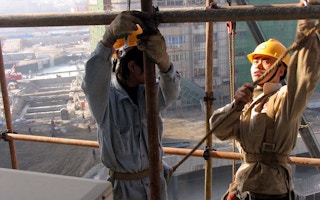Thermoplegia may be a medical term, but it’s been a hot topic this summer.
It is the most serious form of heatstroke, caused by excessive temperature and humidity, leading to loss of the ability to self-regulate temperature. If untreated, it is highly likely to be fatal.
Since mid-June, much of China has been assailed by sustained high temperatures, with frequent reports of acute heatstroke among the elderly and those working outdoors. Some who were not hospitalised died.
On 17 August, the National Climate Centre confirmed that the “regional heatwave incident” had become the worst since records began in 1961.
This will not be the last deadly heatwave. Climate change will make these events more frequent and longer lasting. The centre’s chief forecaster, Chen Lijuan, said climate change could make heatwaves the new normal.
On 21 June, a paper in Climate and Atmospheric Science, led by researchers from South Korea’s Pusan University, found that as atmospheric levels of greenhouse gases increase, East Asia (including China, the Korean peninsula, mainland Southeast Asia and most of Mongolia) will see more frequent and intense heatwaves.
Dry heatwaves and moist heatwaves
The World Meteorological Organisation classes heatwaves as either dry or moist. The dry kind brings clear skies and strong sunshine and occurs mainly in continental or Mediterranean climates, while moist heatwaves mean day-round high temperatures and oppressive humidity, with overnight cloud cover preventing heat from escaping. These mainly occur in mid-latitude temperate and maritime climates.
“
I think that this heatwave in China could not have happened without human-induced global warming.
Kyung-Ja Ha, professor, Pusan National University
In China, the north tends to experience dry heatwaves, while the south gets moist ones.
In the heatwaves paper, the researchers looked at daily temperature data from 1958 to 2019. They define a heatwave as at least three consecutive days where the daily mean temperature is in the 90th percentile or above (that is, in the highest 10 per cent of temperatures).
The researchers then used humidity data to distinguish dry (relative humidity under 33 per cent) and moist (relative humidity over 66 per cent) heatwaves.
The data, as illustrated in the maps below, shows it was dry heatwaves that dominated and got longer in northwest East Asia and adjacent desert regions between 1958 and 2019. Meanwhile, southern parts of East Asia saw more frequent moist heatwaves.
To characterise the combined impact of heat and humidity, the researchers calculated a heat stress index. They found that, over the past 62 years, many dry heatwaves have already reached the “caution” level, while numerous moist heatwaves have reached “extreme caution” and even “danger” levels.
Kyung-Ja Ha, lead author and Professor of Atmospheric Sciences, Pusan National University, told China Dialogue: “We showed that the moist heatwaves have much higher heat stress indexes than those of the dry heatwaves.“ This is because humid air is already saturated with moisture, so sweat is less able to evaporate from the skin and cool the body.
A hotter tomorrow
The researchers also used modelling to predict future heatwaves under three emissions scenarios.
They found that a “middle of the road” emissions scenario (with emissions stabilising by 2050 then starting to fall, but not reaching carbon neutrality by 2100) will see 44.2 days of dry heatwaves and 73 days of moist heatwaves in East Asia during the annual warm season (May to October) by the end of the century.
In a “fossil-fuelled development” scenario (no reduction measures taken, emissions double on current levels by 2050 and more than triple by 2100), there will be 70.6 days of dry heatwaves and 122.1 days of wet heatwaves. In that scenario, heat extremes will become more frequent still: in dry heatwave regions, 38.4 per cent of warm season days will be hotter than presently. In moist heatwave regions, the figure is even higher, at 66.4 per cent.
Even in a low-emissions “sustainability” scenario, days of both dry and moist heatwaves will increase by mid-century. But the use of negative emissions technology would mean a decrease by 2100. However, the relationship between climate systems and greenhouse gases is not linear and contains lag. The intensity and length of heatwaves will therefore continue to increase even when greenhouse gas levels have started to fall.
“We wanted to highlight that the increasing trends in heatwaves will continue even after low or negative emission states, as these are irreversible processes,” said Professor Ha. That means that even if the emissions levels needed for the Paris Agreement’s 1.5C target are reached, more heatwaves will be inevitable.
The modelling shows similar trends in both moist and dry heatwaves under all three scenarios. As greenhouse gas levels increase, dry heatwaves will become more frequent and hotter. Moist heatwaves will become longer with the heatwave season starting earlier and ending later.
Researchers have warned that heatwaves in some parts of China will become more deadly as humidity levels make working outside unsafe. Ha says the deadly heatwave still engulfing China is the consequence of anthropogenic climate change.
“I think that this heatwave in China could not have happened without human-induced global warming. It can be hinted from model simulation results that natural forcings (volcanic activity, solar activity) and pre-industrial control runs with climate models have not simulated this heatwave,” she said.
Ha added that cutting emissions and increasing the effectiveness of carbon-capture tech will help reduce the frequency and intensity of heatwaves. Meanwhile, building eco-friendly cities and installing green roofs will help reduce the urban heat island effect and cut city temperatures, helping us meet future challenges.
This article was originally published on China Dialogue under a Creative Commons licence.










